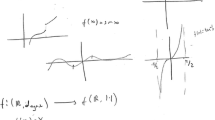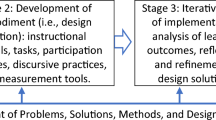Abstract
Many mathematics education researchers have suggested that asking learners to generate examples of mathematical concepts is an effective way of learning about novel concepts. To date, however, this suggestion has limited empirical support. We asked undergraduate students to study a novel concept by either tackling example generation tasks or reading worked solutions to these tasks. Contrary to suggestions in the literature, we found no advantage for the example generation group on subsequent proof production tasks. From a second study, we found that undergraduate students overwhelmingly adopt a trial and error approach to example generation and suggest that different example generation strategies may result in different learning gains. We conclude by arguing that the teaching strategy of example generation is not yet understood well enough to be a viable pedagogical recommendation.




Similar content being viewed by others
References
Antonini, S. (2006). Graduate students’ processes in generating examples of mathematical objects. In J. Novotná, H. Moraová, M. Krátká & N. Stehlíková (Eds.), Proceedings of the 30th International Conference on the Psychology of Mathematics Education (Vol. 2, pp. 57–64). Prague, Czech Republic: IGPME.
Dahlberg, R. P., & Housman, D. L. (1997). Facilitating learning events through example generation. Educational Studies in Mathematics, 33, 283–299.
Ginsburg, H. (1981). The clinical interview in psychological research on mathematical thinking: Aims, rationales, techniques. For the Learning of Mathematics, 1(1), 4–11.
Goldenberg, P., & Mason J. (2008). Shedding light on and with example spaces. Educational Studies in Mathematics, 69, 183–194.
Housman, D., & Porter, M. (2003). Proof schemes and learning strategies of above-average mathematics students. Educational Studies in Mathematics, 53, 139–158.
Marton, F., & Booth, S. (1997). Learning and awareness. Mahwah, NJ: Lawrence Erlbaum Associates.
Mason, J. (2002). Mathematics teaching practice: A guide for university and college lecturers. Chichester, UK: Horwood.
Meehan, M. (2007). Student generated examples and the transition to advanced mathematical thinking. In D. Pitta-Pantazi & G. Phillipou (Eds.), Proceedings of the fifth congress of the European Society for Research in Mathematics Education (pp. 2349–2358). Larnaca, Cyprus: ERME.
Moore, R. C. (1994). Making the transition to formal proof. Educational Studies in Mathematics, 27, 249–266.
Watson, A., & Mason, J. (2001). Getting students to create boundary examples. MSOR Connections, 1, 9–11.
Watson, A., & Mason, J. (2005). Mathematics as a constructive activity: Learners generating examples. Mahwah, NJ: Lawrence Erlbaum Associates.
Watson, A., & Shipman, S. (2008). Using learner generated examples to introduce new concepts. Educational Studies in Mathematics, 69, 97–109.
Weber, K. (2009). How syntactic reasoners can develop understanding, evaluate conjectures, and construct counterexamples in advanced mathematics. Journal of Mathematical Behavior, 28, 200–208.
Weber, K., Porter, M., & Housman, D. (2008). Worked examples and conceptual example usage in understanding mathematical concepts and proofs. In M. P. Carlson & C. Rasmussen (Eds.), Making the connection: Research and teaching in undergraduate mathematics (pp. 245–252). Washington, DC: MAA.
Zaslavsky, O. (1995). Open-ended tasks as a trigger for mathematics teachers’ professional development. For the Learning of Mathematics, 15(3), 15–20.
Zazkis, R., & Leikin, R. (2008). Exemplifying definitions: A case of a square. Educational Studies in Mathematics, 69, 131–148.
Acknowledgements
This research was partially supported by a grant from the Maths, Stats & OR Network of the Higher Education Academy and a Royal Society Worshipful Company of Actuaries Research Fellowship.
Author information
Authors and Affiliations
Corresponding author
Appendix
Appendix
1.1 Instrument used in the proof production study
1.1.1 Example generation tasks
The following definition is about a mathematical concept you have probably not seen before. Please spend a few minutes reading it carefully:
Let f : ℝ → ℝ be a real-valued function. Then f is called fine if it has a root (zero) at each integer. In other words, f is fine if n ∈ ℤ ⇒ f(n) = 0.
You will have 20 min to answer a series of questions about this concept. In each question, you will be asked to provide examples relevant to the concept of fine function. Each question appears on a new page. Write your answers in the space below each question. If you get completely stuck, move on to the next question. Try to answer as many questions as you can in the 20 minutes available.
-
1.
A periodic function is one that repeats its values after a certain period. That is to say that f: ℝ → ℝ is periodic if there exists a P ≠ 0 such that f(x + P) = f(x) for every x ∈ ℝ. P is called the function’s period.
-
(a)
Find an f which is fine and periodic with period \(\frac{1}{2}\).
-
(b)
Find another such f.
-
(a)
-
2.
Let f(x) = sin(kx), where k ∈ ℝ. Give two examples of values of k for which f is fine.
-
3.
Let f(x) = cos(ax + b). Give an example of a pair of values a,b for which f is fine.
-
4.
-
(a)
Draw a function which is fine but not periodic.
-
(b)
Draw another such function.
-
(a)
-
5.
-
(a)
Find f: ℝ → ℝ such that f is fine and periodic with period 1.
-
(b)
Find another such f.
-
(a)
-
6.
Let f(x) = k, where k ∈ ℝ. Give an example of a value of k for which f is fine.
-
7.
Give an example of a function f:ℝ → ℝ that is fine but not continuous.
-
8.
Draw a fine function that takes no negative values.
-
9.
Draw a fine function that always takes values between \(-\frac{3}{2}\) and 1.
1.1.2 Proof production tasks
In this section, there are four questions, each on a new page. Each question involves proving a statement about fine functions.
-
1.
Let f(x) = ax 2 + bx + c, where a,b,c ∈ ℝ and a ≠ 0. Prove that f is not fine.
-
2.
Let f: ℝ → ℝ and g : ℝ → ℝ be fine functions. Prove that g ∘ f is fine.
[Here (g ∘ f)(x) = g(f(x))].
-
3.
Let f,g : ℝ → ℝ be fine functions. Prove that f + g is a fine function [Here (f + g)(x) = f(x) + g(x)].
-
4.
Let f: ℝ → ℝ be a fine function. Let g: ℝ → ℝ be a function defined by g(x) = f(x − k) for some k ∈ ℤ. Prove that g is a fine function.
1.1.3 Proof marking scheme
Question 1
-
1.
f(x) = ax2 + bx + c is a quadratic equation, which has at most two real roots (by the Fundamental Theorem of Algebra). [2]
-
2.
Consequently, there must exist integers n such that f(n) ≠ 0 [2]
-
3.
So f is not fine. [1]
Question 2
-
1.
Let k ∈ ℤ. Then f(k) = 0, as f is fine. [2]
-
2.
So g(f(k)) = g(0) = 0 as g is fine. [2]
-
3.
So, g ∘ f is fine. [1]
Question 3
-
1.
Let n ∈ ℤ. Then f(n) = g(n) = 0 as f and g are fine. [2]
-
2.
So f(x) + g(x) = 0 + 0 = 0. [2]
-
3.
So f + g is fine. [1]
Question 4
-
1.
Let n ∈ ℤ. Then n − k ∈ ℤ as k ∈ ℤ. [1]
-
2.
So f(n − k) = 0 as f is fine. [2]
-
3.
So g(n) = f(n − k) = 0. [1]
-
4.
In other words, g(x) = 0 whenever x ∈ ℤ. [1]
1.2 Instrument used in the example generation study
The following definition is about a mathematical concept you have probably not seen before. Please spend a few minutes reading it carefully:
Let f : ℝ → ℝ be a real-valued function. Let \(A\subseteq\mathbb{R}\). Then f is preserved on A if and only if \(f(A)\subseteq A\). In other words f is preserved on A if and only if \(a\in A\Rightarrow f(a)\in A\).
You will have 20 minutes to answer a series of questions about this concept. In each question, you will be asked to provide examples relevant to the concept of function preservation. Each question appears on a new page. Write your answers in the space below each question. If you get completely stuck, move on to the next question. Try to answer as many questions as you can in the 20 minutes available.
-
1.
Let A be the open interval (1,2).
-
(a)
Find f: ℝ → ℝ such that f is preserved on A.
-
(b)
Find another such f.
-
(c)
Find an f which is strictly decreasing and preserved on A.
-
(d)
Find an f which is strictly increasing and preserved on A.
-
(e)
Find an f which is preserved on A but not continuous on A.
-
(a)
-
2.
Let A be the open interval (1, 2) and B be the open interval (2,3). Find an f : ℝ → ℝ such that f is preserved on A but not on B.
-
3.
Let A be the open interval (1, 2), B be the open interval (2,3) and C be the open interval (3,4). Find an f : ℝ → ℝ such that f is preserved on A and C, but not on B.
-
4.
Let A be the closed interval [ − 1,0]. Find an f : ℝ → ℝ such that f has a local minimum in A and is preserved on A.
-
5.
Let B be the open interval (1, 2). Find f : ℝ → ℝ such that f has a local minimum in B and is preserved on B.
-
6.
Let A be the open interval (1, 2). Find an f : ℝ → ℝ which is not preserved on A.
-
7.
Find f : ℝ → ℝ such that f is preserved on ℕ but not on the set of negative numbers (i.e. not on the set {x ∈ ℝ | x < 0}).
-
8.
Find f : ℝ → ℝ such that f is preserved on ℝ ∖ {0} but not preserved on {0}.
-
9.
Let f be a step function defined by f(x) = max {n ∈ ℤ | n ≤ x}.
-
(a)
Find a set A such that A has five members and f is preserved on A.
-
(b)
Find a,b ∈ ℝ such that a ≠ b and f is preserved on [a, b].
-
(a)
-
10.
Let f(x) = sinx.
-
(a)
Find a ∈ ℝ such that f is preserved on {a}.
-
(b)
Find a, b ∈ ℝ such that a ≠ b and f is preserved on [a,b].
-
(a)
-
11.
Let f(x) = x 13.
-
(a)
Find a set A such that A has two members and f is preserved on A.
-
(b)
Find the largest a ∈ ℝ such that f is preserved on \([-\frac{1}{2},a]\).
-
(a)
-
12.
Let \(f(x)=\left\{ \begin{array}{rl} 0 & \text{if }x = 0 \\ \frac{1}{x} & \text{if }x \neq 0 \end{array} \right. \).
-
(a)
Find a set A such that A has five members and f is preserved on A.
-
(b)
Find m ∈ ℝ such that f is preserved on \(\left[\frac{1}{2},m\right]\).
-
(a)
Rights and permissions
About this article
Cite this article
Iannone, P., Inglis, M., Mejía-Ramos, J.P. et al. Does generating examples aid proof production?. Educ Stud Math 77, 1–14 (2011). https://doi.org/10.1007/s10649-011-9299-0
Published:
Issue Date:
DOI: https://doi.org/10.1007/s10649-011-9299-0




